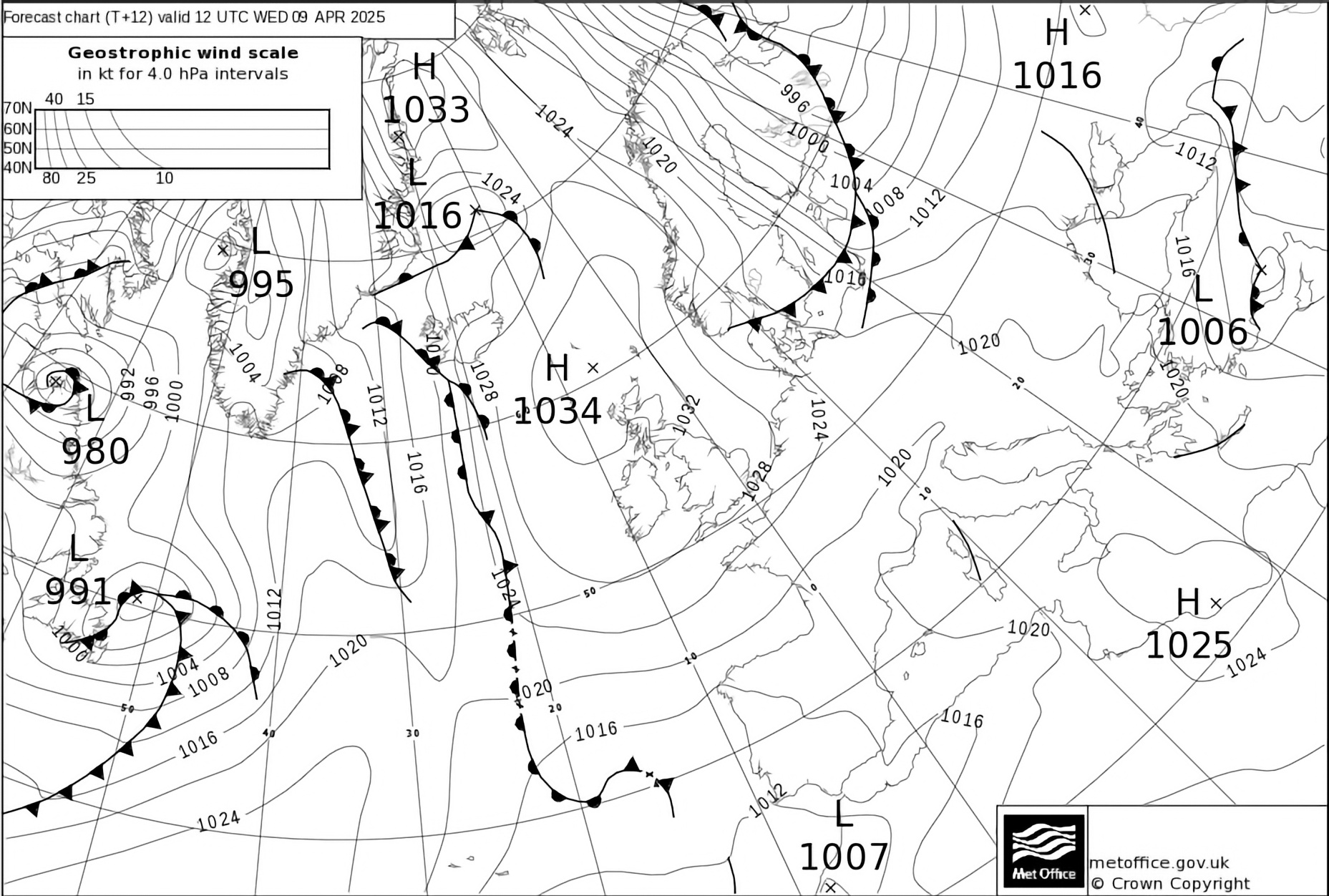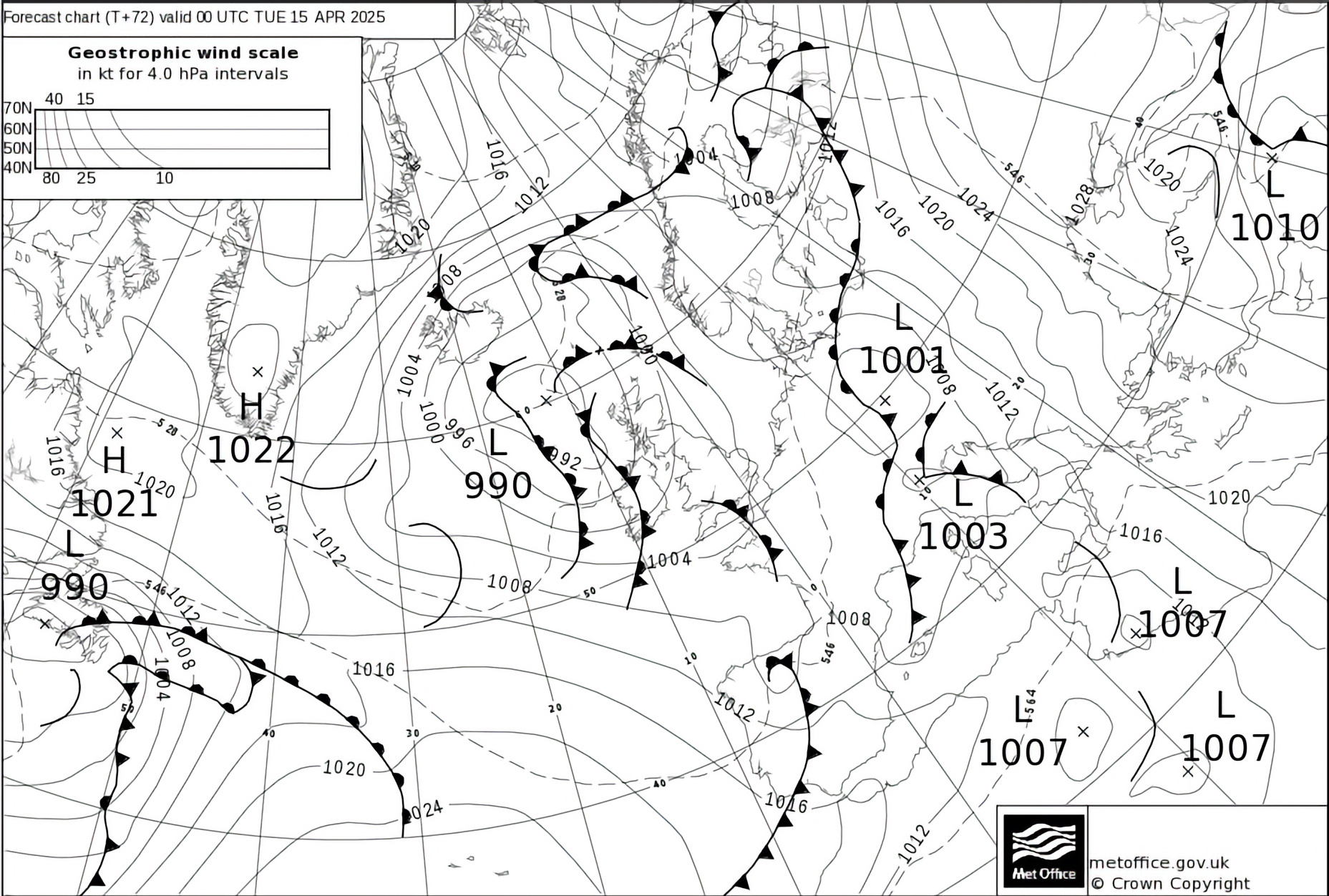PhD Thesis
Ok, so this one is more work than a personal project, but I wanted to give an overview of my work, in a more informal way. The below is a summary of the work I have done over the last four years at the Royal Meteological Institute of Belgium, and the Université catholique de Louvain.
The title of my PhD is: Dynamics of Atmospheric Multi-Scale Systems: A Low-Order Model Perspective.
Weather in the Midlatitudes
The day to day weather in the midlatitudes (approximately $\sim33^\circ-66^\circ$ latitude) is governed by large eddies, called synoptic scale systems [Holton, 2004]. These eddies are made up of relatively high or relatively low pressure that bring, on average, settled and unsettled weather respectively. They are usually around over one thousand kilometres in diameter, and they tend to move from west to east due to the jetstream, which is a fast moving band of air located at an altitude of approximately $10$km [Stendel et al. 2021]. In North Western Europe the flow of the jet brings, on average, warm moist air from the Atlantic, leading to a relatively mild and moist climate.
The eddies in the midlatitudes are generated by instabilities that form in the jetstream. This is called baroclinic instability [Barry and Chorley, 2003], and is caused by the difference in the amount of solar heating that the equatorial region receives, compared with the polar regions. In other words, a temperature gradient exists between the equator and the poles, and this drives the eddies. This temperature gradient is larger in winter and weaker in summer, due to where the sun is hitting the planet. This leads to an increase in baroclinic instability in the winter, which leads to more powerful eddies[Charney, 1947]. Examples of this are storm 'Eowyn that hit Ireland and Britain in early 2025, leading to wind speed records being broken, as well as a strong high pressure systems that brought sustained cold temperatures over the winter of 2017-2018 (storm Emma, a.k.a ``the beast from the east”).
Eddies can also remain over one location for extended periods of time. An example of this is atmospheric blocking, where high pressure systems remain relatively stationary over one geographical location, and the usual westerly (zonal) flow is diverted [Tibaldi and Molteni, 2018], leading to heat waves in summer, or cold snaps in winter. An example of atmospheric blocking, that occurred during April 2025, is shown below. These events can have sever consequences on human health, with tens of thousands of deaths from heat exposure occurring in Europe per year [Bhatnagar, 2024]. As climate change increases the average temperature of the planet, extreme heat events are expected to increase the number of mortalities in the future [Ballester, 2023].


Climate change is impacting the global radiation balance, meaning that the atmosphere captures an increased amount of solar radiation. As we have seen, the weather events of the midlatitudes are driven by a temperature gradients, so a change to the global distribution of heating will impact the weather and possible variability in the midlatitudes [Vallis et al. 2015]. In Western Europe it has been found that climate models are underestimating the temperature and frequencies of extreme temperature events due to changes in the atmospheric circulation [Vautard et al. 2023]. The concern is that the current state of the art models do not accurately capture all of the circulation responses to external forcings, or that they systematically underestimate the strengths of possible eddies. In addition, there is a growing concern that tipping elements in the climate system could alter the climate abruptly and irreversibly [Armstrong et al. 2022]. These tipping elements would could have a major impact on atmospheric circulation. For example, the jet stream over Western Europe could be impacted greatly by the weakening of the Atlantic Meridional Ocean Circulation [Van Westen, 2024].
The variation in possible weather events that is seen in the midlatitudes is referred to as Low Frequency Variability (LFV). This term refers to a large category of possible weather events that can occur over time spans of weeks to months, longer than the life cycle of an individual eddy [Holton, 2004]. This can include blocking events that disrupt the regular movements of eddies which last a week or so, all the way up to interannual variability that can oscillate over the course of years, such as the El Niño-Southern Oscillation [Ghil, 2020].
Our current understanding of how LFV in the atmosphere forms and is still not complete. Numerical Weather Prediction (NWP), or weather forecasting, struggles with accurately forecasting certain aspects of this variability. For example, when atmospheric blocking events will occur or decay [Davini and D’Andrea, 2020]. On the other hand, the inherent variability, or cycling behaviour, offers an opportunity to extend the usual limit of weather forecasting (approximately two weeks), by understanding the mechanisms behind the repeating patterns [Hannachi et al. 2017]. However, this requires understanding the physical mechanisms of this variability. This is where simplified, or idealised, models of the atmosphere can help.
My PhD project was part of a wider project called CriticalEarth, where myself and 14 other PhD students were studying abrupt transitions and tipping points in the climate system.
See more about the wider project at https://www.criticalearth.eu
References
Holton, James R. 2004. An Introduction to Dynamic Meteorology. 4th ed. Vol. 88. International Geophysics Series. Elsevier Academic Press.
Stendel, Martin, Jennifer Francis, Rachel White, Paul D. Williams, and Tim Woollings. 2021. “The Jet Stream and Climate Change.” In Climate Change. Elsevier. https://doi.org/10.1016/B978-0-12-821575-3.00015-3.
Barry, Roger G., and Richard J Chorley. 2003. Atmosphere, Weather and Climate. 8th ed. Routledge. https://doi.org/10.4324/9780203871027.
Charney, J. G. 1947. “The Dynamics of Long Waves in a Baroclinic Westerly Current.” Journal of Meteorology 4 (5): 136–62. https://doi.org/10.1175/1520-0469(1947)004<0136:TDOLWI>2.0.CO;2.
Tibaldi, Stefano, and Franco Molteni. 2018. Atmospheric Blocking in Observation and Models. Vol. 1. Oxford University Press. https://doi.org/10.1093/acrefore/9780190228620.013.611.
Bhatnagar, Bhanu. 2024. “Statement – Heat Claims More than 175 000 Lives Annually in the WHO European Region, with Numbers Set to Soar.” https://www.who.int/europe/news/item/01-08-2024-statement--heat-claims-more-than-175-000-lives-annually-in-the-who-european-region--with-numbers-set-to-soar.
Ballester, Joan, Marcos Quijal-Zamorano, Raúl Fernando Méndez Turrubiates, et al. 2023. “Heat-Related Mortality in Europe during the Summer of 2022.” Nature Medicine 29 (7): 1857–66. https://doi.org/10.1038/s41591-023-02419-z.
Vallis, Geoffrey K., Pablo Zurita‐Gotor, Cameron Cairns, and Joseph Kidston. 2015. “Response of the Large‐scale Structure of the Atmosphere to Global Warming.” Quarterly Journal of the Royal Meteorological Society 141 (690): 1479–501. https://doi.org/10.1002/qj.2456.
Vautard, Robert, Julien Cattiaux, Tamara Happé, et al. 2023. “Heat Extremes in Western Europe Increasing Faster than Simulated Due to Atmospheric Circulation Trends.” Nature Communications 14 (1): 6803. https://doi.org/10.1038/s41467-023-42143-3.
Armstrong McKay, David I., Arie Staal, Jesse F. Abrams, et al. 2022. “Exceeding 1.5°C Global Warming Could Trigger Multiple Climate Tipping Points.” Science 377 (6611): eabn7950. https://doi.org/10.1126/science.abn7950.
Van Westen, René M., Michael Kliphuis, and Henk A. Dijkstra. 2024. “Physics-Based Early Warning Signal Shows That AMOC Is on Tipping Course.” Science Advances 10 (6): eadk1189. https://doi.org/10.1126/sciadv.adk1189.
Ghil, Michael, and Valerio Lucarini. 2020. “The Physics of Climate Variability and Climate Change.” Reviews of Modern Physics 92 (3): 035002. https://doi.org/10.1103/RevModPhys.92.035002.
Davini, Paolo, and Fabio D’Andrea. 2020. “From CMIP3 to CMIP6: Northern Hemisphere Atmospheric Blocking Simulation in Present and Future Climate.” Journal of Climate 33 (23): 10021–38. https://doi.org/10.1175/JCLI-D-19-0862.1.
Hannachi, Abdel., David M. Straus, Christian L. E. Franzke, Susanna Corti, and Tim Woollings. 2017. “Low-Frequency Nonlinearity and Regime Behavior in the Northern Hemisphere Extratropical Atmosphere.” Reviews of Geophysics 55 (1): 199–234. https://doi.org/10.1002/2015RG000509.
